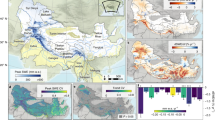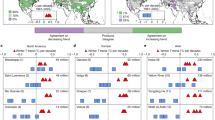Abstract
A temperature-based snow module has been coupled with a grid-based distributed hydrological model, to improve simulations of river flows in upland areas of Britain subject to snowfall and snowmelt. The coupled model has been driven with data from an 11-member perturbed-parameter climate model ensemble, for two time-slices (1960–1990 and 2069–2099), to investigate the potential impacts of climate change. The analysis indicates large reductions in the ensemble mean of the number of lying snow days across the country. This in turn affects the seasonality of peak river flows in some parts of the country; for northerly regions, annual maxima tend to occur earlier in the water year in future. For more southerly regions the changes are less straightforward, and likely driven by changes in rainfall patterns rather than snow. The modelled percentage changes in peak flows illustrate high spatial variability in hydrological response to projected climate change, and large differences between ensemble members. When changes in projected future peak flows are compared to an estimate of current natural variability, more changes fall outside the range of natural variability in southern Britain than in the north.





Similar content being viewed by others
References
Bell VA, Moore RJ (1999) An elevation dependent snowmelt model for upland Britain. Hydrol Process 13:1887–1903
Bell VA, Kay AL, Jones RG, Moore RJ (2007) Development of a high resolution grid-based river flow model for use with regional climate model output. Hydrol Earth Syst Sci 11(1):532–549
Bell VA, Kay AL, Jones RG, Moore RJ, Reynard NS (2009) Use of soil data in a grid-based hydrological model to estimate spatial variation in changing flood risk across the UK. J Hydrol 377(3–4):335–350
Bell VA, Gedney N, Kay AL, Smith R, Jones RG, Moore RJ (2011) Estimating potential evaporation from vegetated surfaces for water management impact assessments using climate model output. J Hydrometeorol 12:1127–1136
Bell VA, Kay AL, Cole SJ, Jones RG, Moore RJ, Reynard NS (2012) How might climate change affect river flows across the Thames Basin? An area-wide analysis using the UKCP09 regional climate model ensemble. J Hydrol 442-443:89–104
Blöschl G, Kirnbauer R, Gutnecht D (1991) Distributed snowmelt simulations in an alpine catchment 1. Model Evaluation on the Basis of Snow Cover Patterns Water Resour Res 27:3171–3179
Booth G (2007) Winter 1947 in the British Isles. Weather 62(3):61–68
Brown S, Boorman P, Murphy J (2010) Interpretation and use of future snow projections from the 11-member Met Office regional climate model ensemble. In: UKCP09 technical note. Hadley Centre, Exeter, UK, Met Office
Capell R, Tetzlaff D, Essery R, Soulsby C (2014) Projecting climate change impacts on stream flow regimes with tracer-aided runoff models - preliminary assessment of heterogeneity at the mesoscale. Hydrol Process 28(3):545–558
Charlton MB, Arnell NW (2014) Assessing the impacts of climate change on river flows in England using the UKCP09 climate change projections. J Hydrol 519:1723–1738
Christierson BV, Vidal J, Wade SD (2012) Using UKCP09 probabilistic climate information for UK water resource planning. J Hydrol 424-425:48–67
Cloke HL, Wetterall F, He Y, Freer JE, Pappenberger F (2013) Modelling climate change impact on floods with ensemble climate projections. Q. J. R. Meteorol Soc 139:282–297
Cole SJ, Moore RJ (2009) Distributed hydrological modelling using weather radar in gauged and ungauged basins. Adv Water Resour 32:1107–1120
Dankers R, Feyen L (2008) Climate change impact on flood hazard in Europe: An assessment based on high-resolution climate simulations. J Geophys Res 113:D19105
Diffenbaugh NS, Scherer M, Ashfaq M (2013) Response of snow-dependent hydrologic extremes to continued global warming. Nat Clim Chang 3:379–384
Dunn SM, Langan SJ, Colohan RJE (2001) The impact of variable snow pack accumulation on a major Scottish water resource. Sci Total Environ 265:181–194
Ficklin DL, Barnhart BL (2014) SWAT hydrologic model parameter uncertainty and its implications for hydroclimatic projections in snowmelt-dependent watersheds. J Hydrol 519:2081–2090
Gosling SN, Taylor RG, Arnell NW, Todd MC (2011) A comparative analysis of projected impacts of climate change on river runoff from global and catchment-scale hydrological models. Hydrol Earth Syst Sci 15:279–294
Hannaford J, Buys G (2012) Trends in seasonal river flow regimes in the UK. J Hydrol 475:158–174
Hough MN, Jones RJA (1997) The United Kingdom Meteorological Office rainfall and evaporation calculation system: MORECS version 2.0-an overview. Hydrol Earth Syst Sci 1:227–239
IPCC (2000) Special report on emissions scenarios (SRES): A special report of Working Group III of the intergovernmental panel on climate change. CUP, Cambridge, UK
IPCC (2013) Climate change 2013: the physical science basis, Contribution of Working Group I to the Fifth Assessment Report of the Intergovernmental Panel on Climate Change [Stocker, T.F. et al. (eds.)]. CUP, Cambridge, UK
Kay AL, Crooks S (2014) An investigation of the effect of transient climate change on snowmelt, flood frequency and timing in Northern Britain. Int J Clim 34:3368–3381
Kay AL, Jones DA (2012a) Transient changes in flood frequency and timing in Britain under potential projections of climate change. Int J Clim 32(4):489–502
Kay AL, Jones RG (2012b) Comparison of the use of alternative UKCP09 products for modelling the impacts of climate change on flood frequency. Clim Chang 114(2):211–230
Kay AL, Davies HN, Bell VA, Jones RG (2009) Comparison of uncertainty sources for climate change impacts: flood frequency in England. Clim Chang 92(1–2):41–63
Kay AL, Crooks SM, Pall P, Stone D (2011) Attribution of autumn/winter 2000 flood risk in England to anthropogenic climate change: A catchment-based study. J Hydrol 406:97–112
Kay AL, Bell VA, Blyth EM, Crooks SM, Davies HN, Reynard NS (2013) A hydrological perspective on evaporation: historical trends and future projections in Britain. Journal of Water and Climate Change 4(3):193–208
Kay AL, Crooks SM, Davies HN, Prudhomme C, Reynard NS (2014a) Probabilistic impacts of climate change on flood frequency using response surfaces. I: England and Wales. Reg Environ Chang 14(3):1215–1227
Kay AL, Crooks SM, Davies HN, Reynard NS (2014b) Probabilistic impacts of climate change on flood frequency using response surfaces. II: Scotland Regional Environmental Change 14(3):1243–1255
López-Moreno JI, Garcia-Ruíz JM (2004) Influence of snow accumulation and snowmelt on streamflow in the Central Spanish Pyrenees. Hydrol Sci J 49:787–802
Moore RJ, Bell VA, Austin RM, Harding RJ (1999) Methods for snowmelt forecasting in upland Britain. Hydrol Earth Syst Sci 3(2):233–246
Morris DG, Flavin RW (1990) A digital terrain model for hydrology. In: Proceedings of the 4th International Symposium on Spatial Data Handling, Zurich, Switzerland, 23–27 July 1990 1:250–262
Murphy JM, Sexton DMH, Jenkins GJ, et al. (2009) UK climate projections science report: climate change projections. Met Office Hadley Centre, Exeter
Nash JE, Sutcliffe JV (1970) River flow forecasting through conceptual models. part I: A discussion of principles. J Hydrol 10(3):282–290
Ohmura A (2001) Physical basis for the temperature-based melt-index method. J Appl Meteor 40:753–761
Pepin N et al. (2015) Elevation-dependent warming in mountain regions of the world. Nat Clim Chang 5:424–430
Perry M, Hollis D, Elms M (2009) The generation of daily gridded datasets of temperature and rainfall for the UK, Climate Memorandum No.24, National Climate Information Centre, Met Office, Exeter, UK
Prudhomme C, Young A, Watts G, et al. (2012) The drying up of Britain? A national estimate of changes in seasonal river flows from 11 regional climate model simulations. Hydrol Process 26:1115–1118
Robson AJ, Reed DW (1999) Statistical procedures for flood frequency estimation, vol 3. Flood Estimation Handbook, Institute of Hydrology, Wallingford, UK
Rudd AC, Kay AL (2016) Use of very high resolution climate model data for hydrological modelling: estimation of potential evaporation. Hydrology Research. doi:10.2166/nh.2015.028
Seiller G, Anctil F (2014) Climate change impacts on the hydrologic regime of a Canadian river: comparing uncertainties arising from climate natural variability and lumped hydrological model structures. Hydrol Earth Syst Sci 18:2033–2047
Soulsby C, Black AR, Werritty A (2002) Hydrology in Scotland: towards a scientific basis for the sustainable management of freshwater resources — foreword to the thematic issue. Sci Total Environ 294:3–11
Stewart IT (2009) Changes in snowpack and snowmelt runoff for key mountain regions. Hydrol Process 23:78–94
Wilson D, Hisdal H, Lawrence D (2010) Has streamflow changed in the Nordic countries? recent trends and comparisons to hydrological projections. J Hydrol 394:334–346
Acknowledgments
This work was undertaken under subcontract to Met Office Hadley Centre and supported by CEH National Capability Funding. RGJ acknowledges funding from the Joint DECC and Defra Met Office Hadley Centre Climate Programme (GA01101).
Author information
Authors and Affiliations
Corresponding author
Electronic Supplementary Material
ESM 1
(PDF 474 kb)
Rights and permissions
About this article
Cite this article
Bell, V.A., Kay, A.L., Davies, H.N. et al. An assessment of the possible impacts of climate change on snow and peak river flows across Britain. Climatic Change 136, 539–553 (2016). https://doi.org/10.1007/s10584-016-1637-x
Received:
Accepted:
Published:
Issue Date:
DOI: https://doi.org/10.1007/s10584-016-1637-x




